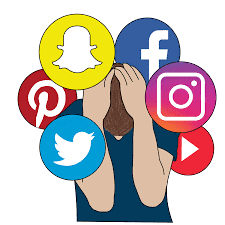
In today’s linked world, social media has become bound in the lives of people everywhere, including those in Lebanon. Due to the many platforms and features that social media provides, it has radically altered the way that young people connect and show themselves. Even while social media offers numerous benefits, such as rapid connectivity and information accessibility, it also has significant disadvantages for the social, emotional, and mental health of Lebanese youth. This paper includes research that will investigate how social media affects young people in Lebanon, highlighting both the benefits and drawbacks of their online activities. Finally, it can be said that social media has a complex and diverse effect on young people in Lebanon. Although it provides opportunities for communication, self-expression, and information sharing, social media also raises problems with mental health, self-esteem, cyberbullying, and social relationships. Recognizing and addressing these effects is essential if we want to promote safe and ethical social media use among young people in Lebanon.
For many young people in Lebanon, social media has become an essential aspect of daily life. 95% of Lebanese youth use social media, with the typical user spending 3 hours per day on these platforms, according to a study by the American University of Beirut(2019). The extensive usage of social media has had a huge harmful and good impact on Lebanese youth life.
Akram and R. Kumar mention in their study “A Study on Positive and Negative Effects of Social Media on Society” some positive and negative impacts of social media. In a positive side, People can use social media to interact with other people, establish connections, and maintain contact with friends and family. Furthermore, it can be used to exchange knowledge, discover new things, and engage in innovative thinking. Also, social media may also be used to encourage individuals to take act and increase knowledge of significant social concerns. On the other hand, some negative impacts mentioned include Addiction to social media, which can result in issues including lack of sleep, poor school performance, and social isolation and can draw people into the point where they abandon their career, school, or relationships in favor of it. Moreover, Misinformation, cyberbullying, and hate speech can all be spread on social media where people could judge themselves against others and feel inferior. They might also be concerned with their internet reputation and how others view them. In addition, Social media can also cause people to have inflated expectations of what life will be like and can exacerbate mental health issues like anxiety and sadness.
The growing number of youths using social media without understanding its implications is a major concern for both the world globally and Lebanon particularly. For this reason, Understanding the influence of social media on youth in Lebanon is crucial. I thereby carried out research to address the following question: ” How much do Lebanese young adults use of social media affect their body image, self-esteem, and their well-being (physically, mentally and socially)?
Social media and global history:
History of Communication and Information Sharing:
According to Rogers (2019) and Mather (2022), the history of communication and information exchange goes back many centuries. Every era, from ancient times to the present, has seen the adoption of various technologies that have influenced how people share and interact with information. From the earliest forms of oral tradition to the development of the letters, telegraph, telephone, radio, and finally the internet, communication has changed how people interact and share information with one another.
Communication back then was largely based on oral tradition, with knowledge being passed down orally from one generation to the next. Writing systems originated as societies developed, such as symbols in ancient Egypt and the creation of alphabets in different cultures. These written forms made it possible to record and preserve ideas, allowing the transfer of knowledge through time.
The field of communication had been completely transformed when Johannes Gutenberg created the printing press in the 15th century. It made it possible to produce books in large quantities and led to the rise of literacy, making it possible to disseminate information more extensively than ever.
In the 19th and 20th centuries, developments in telegraphy, telephone, and radio made it possible to send thoughts in the moment over great distances.
The development of television in the middle of the 20th century made visual communication more common and made it possible and easy to send out news, entertainment, and cultural content to large audiences. However, the public’s opinion and culture were significantly shaped by television.
The global sharing of knowledge and data was revolutionized by the internet, a significant invention of the late 20th century. It made it achievable to create websites, send messages and emails, and ultimately create social media platforms. Through the use of the internet, people may interact with one another, exchange information, and participate in online activities that extend beyond geographical limits.
Youths are now able to communicate with people from different cultures all around the world through social media and the range of platforms that it offers. These platforms also enable people to share their ideas, opinions, pictures, and videos with a worldwide audience. In the world of news, it also changed the way information is disseminated; for instance, social media has supplanted traditional news outlets including newspapers, television, and other traditional media. It is now the primary source of real-time news and updates. Social media has also completely changed how news is distributed and received. As key providers of news and information, social media platforms have replaced traditional media outlets like newspapers and television. Now, people have instant access to news updates and analysis.
Potential implications of the effects of social media on teenagers in Lebanon:


Youth use of social media has further impact on the future in many aspects such as politics, , and even culture. For example, as social media enhances communication, sharing of opinions, raising awareness and awakening are improved. This may lead to social mobilization and act and the current power system may shift and crumble.
Social media influenced public opinion at the political level. For example, in Lebanon according to the article “The Effectiveness of Social Media in Youth Political Participation in Lebanon” since the Internet’s creation, new digital channels have proliferated, and as a result, the Internet and its impact on politics have altered. The spread of news and political messages via social media is frequently thought to be crucial (Chadwick, 2013). On social media, the young people participated in a range of political activities, such as political advocacy, political campaigns, correspondence with politicians, political debates, monitoring and reporting electoral fraud, public consultations, joining lobbying interest groups, blogging about political issues, and writing letters to elected officials. As well as participating in political activities, young people in Lebanon utilize social media to distribute political news and video speeches.
Social media has a cultural impact on how individuals communicate and connect. By tearing down the barriers between various cultures, it transformed societal conventions. Today, everyone may access whatever information they desire, and people are exposed to a variety of cultures every day, which impact on how a person thinks and acts, for example, by changing their eating habits and how they dress. This will alter and delete Several traditions and cultural standards that the next generation won’t be familiar with.
Literature review:

Bitar (2020) stated that in order to provide a picture of how children in Lebanon utilize the internet and the kinds of dangers they encounter online, social media Exchange polls was given to 157 youngsters between the ages of 14 and 22. Participants from a range of backgrounds in Lebanon. She added that it is rare to find parents or other parental figures actively participating in their children’s internet presence and activities. She added that 38 percent have unrestricted access to everything they want, anytime they want, for as long as they want. According to 78 percent of respondents, parents cannot control the programs their kids are allowed to use since they do not have administrative access to their kids’ computers or other electronic devices. Also, the In terms of privacy, the report states that just 26% of males are unconcerned about their internet privacy, compared to 46% of female participants… Moreover, 86 percent reveal their identity online, and almost 33 percent have their phone number available on social media…
Getting to the social media impact on youth in Lebanon. In the article “Effects of Social Networking on Teens in Lebanon, Digital Media Effects in Lebanon.” The writer shows the consequences of social media on a psychological, mental and physical level. As he mentions, one of the serious effects is Loss of Focus where Teenagers frequently drift away from reality as well as from their academic and athletic schedules. They strive to be the first to comment or like a post. Moreover, cyber security where it’s when an adolescent is harassed, threatened, shamed or disrespected online or through another digital platform. This can result in significant psychological and even physical issues, which can occasionally result in suicide or hurting oneself or others. In addition to many physical consequences such as obesity and poor eyesight due to excessive screen usage without sufficient outdoor time or exercise.
Furthermore, the study “Effects of social media on relationships in Lebanon: A study case for Lebanon “acknowledged that social media helps people especially teens to communicate their ideas and emotions and to get social support. Nevertheless, the study also shows that it could have unfavorable consequences. This study examined at how social media use affects family and marital happiness in Lebanon. It’s very likely that social media is fostering an addict culture, stated the author. The study’s findings demonstrated the current influence of social media use on relationship quality. Social media use causes relationships between families and couples to become more tense every day. 90% of participants who have highly connected children report that they rarely talk to them about things they’ve seen on social media. In spite of this, 76% of people feel that technology separates children from their parents. And a home technology policy is absent in 46% of households with children.
Methodology:

- Data Collection:
Quantitative Data Collection: Surveys and questionnaires are used to gather this type of information. Utilizing proven scales or creating measurement tools to evaluate social media usage patterns, body image, self-esteem, and overall wellbeing. These tools involve the distribution of a series of organized inquiries to participants in order to collect information on participants’ usage, routines, behaviors, and expectations about the effects of social media. In surveys and questionnaires, polls, multiple-choice questions are employed.
- Sampling:
A group of young people (between the age of 17 and 25) in Lebanon who regularly use social media. To ensure variety and universality of outcomes, characteristics including ages, sex, and geographical region are taken into account. Methods like random sampling are used.
Teenagers in Lebanon who regularly use social media platforms make up the sample group for the study. The study population’s approximate age range is between the ages of 17 and 25 years old, to concentrate on young people. Since they would be able to provide valuable information about how social media is affecting their lives, it is crucial to concentrate on those that are already utilizing the various platforms. In order to gain an in-depth understanding of the impact of social media on youth throughout various demographics, the study population may comprise both males and females from various socioeconomic origins, educational levels, and geographic areas within Lebanon.
- Different Sections of my Survey:
Section 1: Participant Information
This section aims to collect demographic information about the participants like age, gender, place of residence in Lebanon and nationality…
Section 2: Social Media Use
This section delves into the platforms preferred by participants and their usage patterns, exploring the underlying motivations behind their choices. It further examines the pivotal role of social media in raising awareness about social issues in Lebanon, shedding light on its contribution to promoting and disseminating information regarding the aftermath of the Beirut explosion. Additionally, the study analyzes the profound impact of social media on individuals’ behavior and perceptions during the COVID-19 pandemic in Lebanon. It delves into participants’ emotional responses following social media engagement and their perceptions of its role in fostering cultural diversity and inclusivity within the Lebanese context. Lastly, the research investigates participants’ involvement in online activism or social justice campaigns related to Lebanon through various social media platforms.
Section 3: Well-being (Physical, Mental, and Social)
This section looks into the effects of these platforms on people’s general health. First, on a physical level, such as sleep patterns and other physical effects. Then, considering its psychological implications such as anxiety and depression. Finally, social issues including loneliness, cyberbullying, and more.
Ethical concerned:
The following ethical factors were taken into account when conducting the research:
- Full Agreement: Participants must give their informed consent. They need to be properly informed about the goals of the research, any possible dangers and benefits and their privileges.
- Participants’ security and anonymity should be maintained at all times during the research procedure.
- Reducing Hurt and Emotional Effects: I was conscious of the participants’ possible emotional reactions to the study topic. I took the necessary precautions to lessen any possible suffering. This involves assuring participant mental health.
- Data Analysis and Conclusion:

The research participants comprised individuals across various age groups, predominantly falling within the 17-25 years range. The gender distribution included both males and females. They hailed from diverse regions in Lebanon, including Beirut, Mount Lebanon, and South Lebanon. The findings revealed a range of social media usage patterns, with respondents reporting varying amounts of time spent on these platforms per day. Some participants spent 1-2 hours, while others dedicated more than 4 hours to social media activities. The most commonly used social media platforms among the respondents were Facebook, Instagram, tiktok, youtube and whatsapp.
The study highlighted the primary purposes for which young adults utilized social media, which included connecting with friends and family, as well as discovering and consuming content such as news and entertainment. In the context of the Beirut explosion and the COVID-19 pandemic in Lebanon, social media played a crucial role in keeping respondents informed about the aftermath of the explosion and providing updates on the pandemic. However, the research also revealed that social media had both positive and negative influences on respondents’ behavior and perceptions during these events. While it facilitated access to information, it also contributed to feelings of anxiety and confusion due to the presence of misinformation.

In terms of body image, a significant percentage (46.2%) of respondents believed that social media had a negative impact on their perception of their own bodies. Additionally, 38.5% reported frequently comparing their body and beauty to models, influencers, and others on social media, experiencing pressure to meet certain standards promoted online. This phenomenon was more prevalent among girls. Notably, around 50% of participants confirmed that social media had lowered their self-esteem, while approximately 30% reported positive impacts on self-esteem, and the remainder reported no impact.
Regarding mental health and self-perception, respondents had mixed views on the impact of social media. About 38.5% reported positive effects, such as boosted self-esteem, while 61.5% reported negative impacts, including lowered self-esteem, anxiety, and feelings of depression. Furthermore, 69.2% felt isolated as a result of their social media usage. Approximately 53.8% believed that social media had both negative and positive impacts on their mental health.
Regarding physical impacts, 46.2% of respondents reported that social media occasionally disrupted their sleep patterns, while 53.8% experienced physical symptoms such as eye strain and headaches.
The findings of our research shed light on the impact of social media usage on the body image, self-esteem, and overall well-being of young adults in Lebanon. It is evident that social media plays a significant role in shaping these aspects, with both positive and negative effects observed. When it comes to body image, consequently, constant exposure to such comparisons and unattainable visualizations on social media had detrimental effects on their body image and self-esteem.

Turning to self-esteem and mental health, our research revealed a mixed picture. While some respondents reported positive impacts, such as boosted self-esteem, a majority experienced negative consequences. These included lowered self-esteem, heightened anxiety, and feelings of depression. Moreover, social media use was found to contribute to feelings of isolation for a significant portion of the participants. It is worth noting that more than half of the respondents acknowledged both positive and negative influences of social media on their mental well-being.

In terms of physical well-being, a notable percentage of participants indicated that social media occasionally disrupted their sleep patterns. Additionally, many reported experiencing physical symptoms like eye strain and headaches as a result of their social media usage. These findings underscore the significant role of factors such as peer comparison and exposure to unrealistic visualizations in shaping the observed effects. The constant exposure to carefully curated images and the pressure to conform to societal standards perpetuated on social media platforms have detrimental consequences for body image, self-esteem, and overall well-being.

Given these results, it is crucial to prioritize the development of digital and media literacy skills among young adults in Lebanon. Raising awareness about the potential negative impacts of excessive social media use, particularly in relation to body image, self-esteem, and mental health, is of utmost importance. Encouraging critical thinking and self-reflection can empower individuals to establish healthier relationships with social media platforms and mitigate the adverse effects of comparison and exposure to unrealistic visualizations.

Furthermore, it is essential to foster a supportive and inclusive online environment that promotes body positivity and mental well-being. In conclusion, our research highlights the need for individuals, communities, and society as a whole to recognize and address the potential negative impacts of social media on body image, self-esteem, and overall well-being. It calls for collective action to cultivate a balanced and healthier relationship with social media, empowering individuals to embrace their unique identities and safeguard their mental and physical well-being in the digital age.
References:
Akram, W., & Kumar, R. (2017). A Study on Positive and Negative Effects of Social Media on Society. International Journal of Computer Sciences and Engineering, 5(10), 351–354. https://doi.org/10.26438/ijcse/v5i10.351354
Bitar, L. (2020, July 29). Youth, Internet, and Technology in Lebanon: A Snapshot. SMEX. https://smex.org/youth-internet-and-technology-in-lebanon-a-snapshot/
Brzozowski, A., & Vytiska, H. (2017). How the Cold War was replaced with fake news. www.euractiv.com. https://www.euractiv.com/section/cybersecurity/opinion/fake-news-has-become-the-new-lying-press/
Effects of Social Networking on Teens in Lebanon, Digital Media Effects in Lebanon. (n.d.). https://www.lebanoneducation.info/career-options/career-guide/effects-of-social-networking-on-teens.html
Ghaddar, A., Hamadani, M., & Yamout, F. (2019). Effects of social media on relationships in Lebanon: A study case for Lebanon. In BCS Learning & Development. British Computer Society. https://doi.org/10.14236/ewic/pom19.8
Influence of Social Media – Be United. (n.d.). https://www.be-utd.org/social_media_influence.html
Reducing Social Media Use Significantly Improves Body Image in Teens. (n.d.). MTV Lebanon. https://www.mtv.com.lb/en/news/articles/1347229/reducing-social-media-use-significantly-improves-body-image-in-teens
Rogers, S. (2019, October 15). The Role Of Technology In The Evolution Of Communication. Forbes. https://www.forbes.com/sites/solrogers/2019/10/15/the-role-of-technology-in-the-evolution-of-communication/
The Evolution Of Communication | CFH Docmail. (n.d.-a). https://www.cfh.com/insights/blogs/communications/a-brief-history-on-the-evolution-of-communication/
The Evolution Of Communication | CFH Docmail. (n.d.-b). https://www.cfh.com/insights/blogs/communications/a-brief-history-on-the-evolution-of-communication/
Vraga, E. K., & Bode, L. (2021). Addressing COVID-19 Misinformation on Social Media Preemptively and Responsively. Emerging Infectious Diseases, 27(2), 396–403. https://doi.org/10.3201/eid2702.203139











